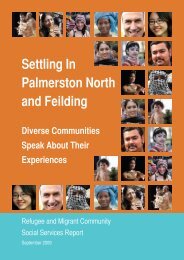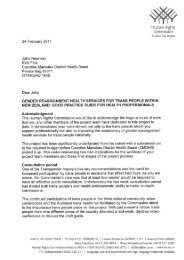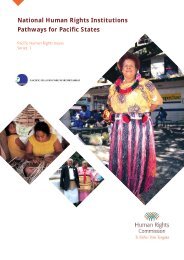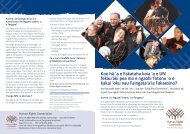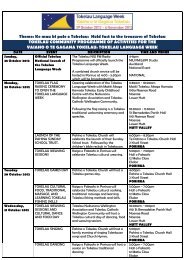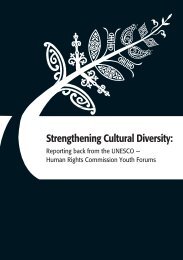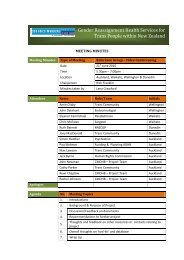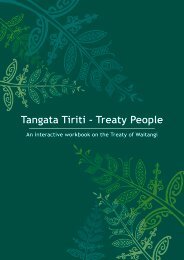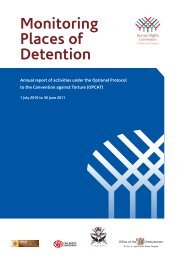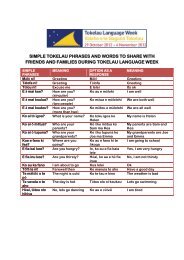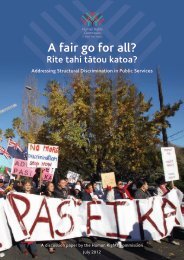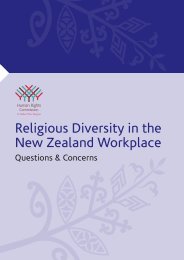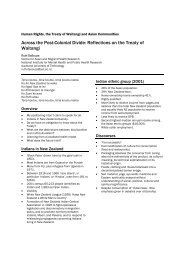16. Rights of Children and Young People - Human Rights Commission
16. Rights of Children and Young People - Human Rights Commission
16. Rights of Children and Young People - Human Rights Commission
Create successful ePaper yourself
Turn your PDF publications into a flip-book with our unique Google optimized e-Paper software.
256<br />
SECTION FOUR – RIGHTS OF SPECIFIC GROUPS<br />
Recent <strong>and</strong> pending pieces <strong>of</strong> legislation (such as the Care<br />
<strong>of</strong> <strong>Children</strong> Act 2004, the Evidence Act 2006 <strong>and</strong> the<br />
<strong>Children</strong>, <strong>Young</strong> Persons <strong>and</strong> their Families Amendment<br />
Bill (No. 6)) provide for improved recognition <strong>and</strong> opportunities<br />
for children <strong>and</strong> young people to express their<br />
views <strong>and</strong> for these to be taken into account. 102 In some<br />
areas, however (notably adoption legislation) provision<br />
for children’s participation in decisions remains limited.<br />
Examples <strong>of</strong> initiatives to facilitate <strong>and</strong> enhance children’s<br />
participation include:<br />
• forums <strong>and</strong> events, such as Youth Parliament, Youth in<br />
Local Government Conference, Youth Week <strong>and</strong> Kids<br />
Voting 2008<br />
• tools <strong>and</strong> resources that encourage <strong>and</strong> assist agencies<br />
to obtain <strong>and</strong> incorporate children’s views, such as<br />
those developed by the Ministry <strong>of</strong> Youth Development<br />
(MYD)<br />
• advisory groups, such as the <strong>Children</strong>’s <strong>Commission</strong>er’s<br />
<strong>Young</strong> <strong>People</strong>’s Reference Group, the MYD Activate<br />
group <strong>and</strong> Aotearoa Youth Voices Network, <strong>and</strong> local<br />
government youth councils.<br />
At local government level, many local authorities have<br />
youth councils, reference groups <strong>and</strong>/or youth policies. The<br />
long-term community council plans process under the Local<br />
Government Act 2002 increasingly sees young people as a<br />
population to consult specifically. Such measures are particularly<br />
important, given the impact that local government<br />
decisions have on the lives <strong>of</strong> children. However, provision<br />
for children’s views to be heard is still not consistent<br />
or automatic. In the recent major reforms <strong>of</strong> Auckl<strong>and</strong><br />
local government, there is a lack <strong>of</strong> provision in the draft<br />
legislation for mechanisms to ensure that children’s perspectives<br />
are heard <strong>and</strong> taken into account in decision-making<br />
processes in the new Auckl<strong>and</strong> Council. 103<br />
Online social networks, content sharing sites <strong>and</strong> devices<br />
such as iPods <strong>and</strong> mobile phones are now fixtures <strong>of</strong><br />
youth culture. 104 New media forms have altered how<br />
young people socialise, learn, participate, organise <strong>and</strong><br />
take action. The growth in use <strong>of</strong> electronic communication<br />
media such as social networking sites <strong>of</strong>fers<br />
new means <strong>of</strong> involving children <strong>and</strong> young people <strong>and</strong><br />
enabling them to express their views on issues. These fora<br />
are increasingly being used by agencies <strong>and</strong> organisations<br />
for this purpose.<br />
Digital stories created by young people, as part <strong>of</strong> a<br />
youth shadow report to the CRC, illustrate that children<br />
<strong>and</strong> young people have powerful stories <strong>and</strong> valuable<br />
perspectives to share on a wide range <strong>of</strong> issues. Examples<br />
<strong>of</strong> issues <strong>of</strong> concern to these young people include<br />
awareness <strong>of</strong> rights; discrimination <strong>and</strong> racism; violence<br />
<strong>and</strong> gangs; education; being listened to by decisionmakers;<br />
environmental issues; <strong>and</strong> the importance <strong>of</strong><br />
caring families <strong>and</strong> communities. 105<br />
I believe I have a voice. I know more than you<br />
think. I hate it when they don’t ask for my<br />
opinion. 106<br />
Conclusion<br />
Whakamutunga<br />
The situation for most children <strong>and</strong> young people in New<br />
Zeal<strong>and</strong> is generally positive. Most children are able to<br />
enjoy their human rights <strong>and</strong> are protected <strong>and</strong> cared for,<br />
with opportunities to learn, develop <strong>and</strong> have fun. Since<br />
2004, there have been some significant developments in<br />
the key areas <strong>of</strong> health, education, justice <strong>and</strong> material<br />
well-being that have impacted positively on the lives <strong>of</strong><br />
children.<br />
However, children remain relatively invisible. Their<br />
rights <strong>and</strong> interests are not routinely considered, nor<br />
102 For example, both the Care <strong>of</strong> <strong>Children</strong> Act 2004 (e.g. section 6) <strong>and</strong> the <strong>Children</strong>, <strong>Young</strong> Persons <strong>and</strong> their Families Amendment (No. 6)<br />
Bill provide that a child or young person must be given reasonable opportunities to express their views <strong>and</strong> their views must be taken into<br />
account. The Evidence Act 2006 makes it m<strong>and</strong>atory for the court to hear an application on how a child applicant is to give their evidence.<br />
Options include evidence being presented from behind a screen, from an appropriate place outside the court. <strong>and</strong> by video recording.<br />
103 Office <strong>of</strong> the <strong>Children</strong>’s <strong>Commission</strong>er (2010), Making Auckl<strong>and</strong> a Great Place for <strong>Children</strong> (Wellington: OCC), March<br />
104 Ito M et al (2008), Living <strong>and</strong> Learning with New Media: Summary <strong>of</strong> Findings from the Digital Youth Project. Accessible online at http://<br />
digitalyouth.ischool.berkeley.edu/files/report/digitalyouth-TwoPageSummary.pdf<br />
105 Information on the project <strong>and</strong> digital stories accessible online at http://a12aotearoa.ning.com/ See also Beals F <strong>and</strong> Zam A (2010), Hear<br />
our voices we entreat: Save The <strong>Children</strong> NZ Child Participation Report to the UN Committee on the <strong>Rights</strong> <strong>of</strong> the Child (Wellington: Save<br />
The <strong>Children</strong> NZ)<br />
106 Beals F <strong>and</strong> Zam A (2010) Decisions get made without our opinions, one <strong>of</strong> the digital stories available at http://a12aotearoa.ning.com/<br />
video



